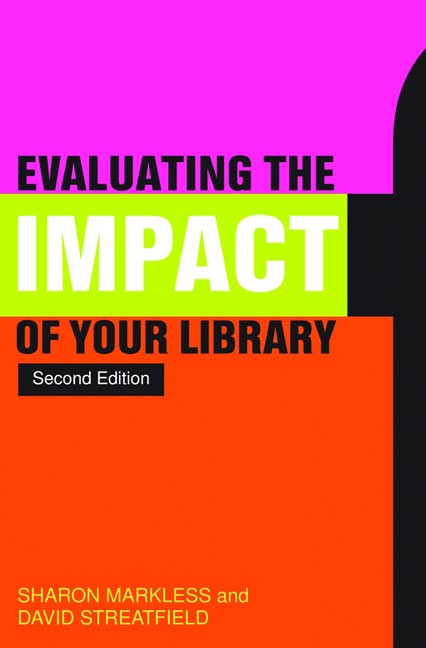Book contents
- Frontmatter
- Dedication
- Contents
- Introduction
- About the authors
- Impact and all that: use of some key terms in this book
- Part 1 The Context
- 1 The demand for evidence
- 2 Getting to grips with impact
- 3 The research base of this work
- Part 2 Evaluating Impact
- Part 3 The Bigger Picture
- References
- Notes
- Index
- Evaluating and Measuring the Value, Use and Impact of Digital Collections
- Measuring Library Performance
- Miscellaneous Endmatter
3 - The research base of this work
from Part 1 - The Context
Published online by Cambridge University Press: 08 June 2018
- Frontmatter
- Dedication
- Contents
- Introduction
- About the authors
- Impact and all that: use of some key terms in this book
- Part 1 The Context
- 1 The demand for evidence
- 2 Getting to grips with impact
- 3 The research base of this work
- Part 2 Evaluating Impact
- Part 3 The Bigger Picture
- References
- Notes
- Index
- Evaluating and Measuring the Value, Use and Impact of Digital Collections
- Measuring Library Performance
- Miscellaneous Endmatter
Summary
If your main aim now is to get to grips with impact evaluation in your library, you may like to skip this chapter. On the other hand, if you are interested in what the literature has to say about impact evaluation and, more specifically, if you want to know about the research that underpins this book – please read on.
This chapter looks at some of the main recent advances in evaluating impact in other sectors, how these have influenced our thinking and how they can help library service managers in evaluating impact. We then home in on the library and information research and what it tells us about the overall impact of various types of libraries. Finally, we outline the research base of our own work leading to this book.
What we know about impact from the management literature
Fortunately, perhaps, we don't have space here to trace all the twists and turns of researchers and management gurus who moved on from traditional performance measurement in a quest to determine the impact of services. Instead, we will look at a few important staging posts along the way.
We have pointed to a shift in focus, away from monitoring processes and outputs using traditional performance indicators (busy-ness statistics) towards ‘higher-order outcomes’, ‘impact’ or ‘achievement’ – or from monitoring efficiency to gauging effectiveness. Earlier we noted the danger of adopting too narrow a focus on value for money or costs as the determining factor. The two main approaches described next arise out of concern to get a broad perspective on effectiveness and to translate this into practical evaluation action. Both versions were generated in the world of business and both are sufficiently widely used to make it worth considering them here.
The balanced scorecard
A useful way of ensuring balance in generating indicators comes in the form of the ‘balanced scorecard’. This approach was developed in business in the USA as a result of concern that financially based performance measurement systems are likely to produce a ‘control bias’ (as noted in section 1.3.2 above):
The balanced scorecard, on the other hand … puts strategy and vision, not control, at the center. It establishes goals but assumes that people will adopt whatever behaviors and take whatever actions are necessary to arrive at those goals.
Kaplan and Norton (1992)- Type
- Chapter
- Information
- Evaluating the Impact of Your Library , pp. 33 - 58Publisher: FacetPrint publication year: 2012



